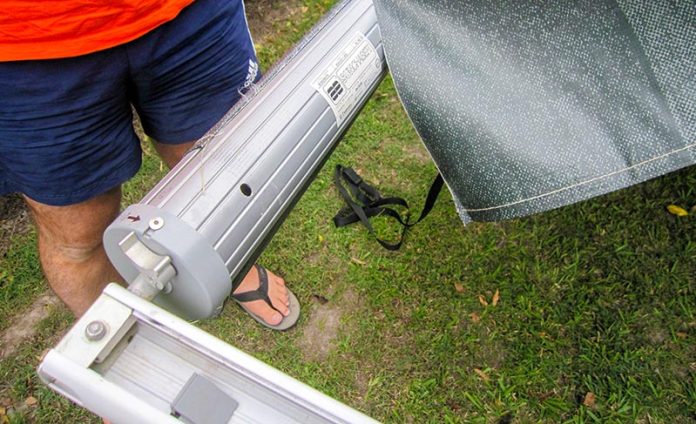If you’re thinking about buying your first caravan, looking to upgrade to something bigger, or even downsizing, the hunt for a good secondhand caravan can be an exciting time. But we think it’s a much better process when you’re armed with some top tips to help you avoid a lemon. Here’s what you need to know to help get a great deal.
BUYER TRAPS
The last thing you want to do is rush the buying process. The following are some points to consider, especially if you’re purchasing for the first time:
- Can your current vehicle legally tow the caravan you’re considering?;
- Look through ‘secondhand caravan’ advertisements to see what you can get for your money;
- Consider what’s essential versus what would be nice to have;
- Buying a ‘fixer upper’ might be on your radar, but be sure you know what it’s going to cost to get it safe, legal and on the road;
- Be very clear on your budget;
- Ask an experienced RVer for some advice because they have no emotional attachment; and
- Don’t let emotion take over your finances.
DUE DILIGENCE
Begin researching well before handing over your hard-earned cash. Read magazines and publications and visit caravan shows. They’re a great place to ask questions and you’ll get to see a range of van types, styles and features, all in one place. Asking questions on forums such as Facebook will, no doubt, provide a barrage of conflicting answers, so don’t rely on these – everyone has differing opinions.
You’ll also find online sites that sell RVs and advertise both private and dealer sales. By including the year of manufacture in the search function, you’ll learn what price you can expect to pay as the caravan ages.

Now you’re armed with a bundle of information, load it all into a spreadsheet to produce your own buyer’s guide table. It will help determine what that particular type of caravan is currently selling for. Pay particular attention to the caravan’s specs and options to ensure you’re comparing apples with apples.
GETTING BANG FOR YOUR BUCK
Draw up a list of specs so you know exactly what you’re looking for. Treat a ‘must’ as something that’s not negotiable. In other words, if that item is not included, then you’re not buying the van. It’s as simple as that. It’s no good getting a 2600kg ATM caravan if it can’t be towed legally by your present vehicle – unless you’ve factored the cost of a tow vehicle upgrade in your budget.
On the other hand, a ‘want’ is something you desire. These are items that become trade-offs and generally dollar-driven. You might feel you need a shower and toilet, but your budget only allows a combination unit rather than a full or separated ensuite.
Once your list of specs is complete, it’s time to go window shopping. No, you’re not ready to buy just yet… you’re only looking. Head out and visit some dealers because it’s your perfect opportunity to test out all your research first-hand.
SECONDHAND CARAVAN: DEALER OR PRIVATE?
It doesn’t matter whether you’re looking to purchase from a dealer or privately, there’s things to take into consideration for both. Dealers have multiple vans at one location, making it easier for a buyer to compare and negotiate. They can also demonstrate how things operate and provide details on technical towing requirements/current weight specs.

Reputable dealers will also conduct a thorough check of the entire van, from the tyres up. This includes all operating systems, appliances and roadworthy items, and dealers should provide the purchaser with a written report. When purchasing a used caravan from a dealer, the purchaser has certain consumer guarantees under Australian Consumer Law.
When buying privately, it’s buyer beware. You need to be prepared to do a lot more homework on the caravan and its associated documents. Be sure to check the ownership status to determine whether there’s any finance owed, or any record that the van has been damaged, written off or ‘re-birthed’. Sellers can also be reluctant to allow tools to be used or for you to do a tow test because of insurance-related concerns.
As the purchaser, this can leave you holding the risk. The main benefit of private sales is in the purchase price, as this is where you can pick up some real bargains. But a word of warning: a saving today can be long forgotten if it needs major money spent at its first service!
BEFORE YOU SIGN
If you’ve looked at a range of secondhand caravans and think you’ve found ‘the one’, what next? We suggest preparing a detailed checklist to assist you with an inspection. The results might also help to negotiate a better price. Download one of the many inspection checklists found online and refer to it while taking your time as you inspect the van. Don’t be shy – if you’re unsure how something works, ask. For a modest fee, you can even engage an independent expert to conduct an inspection.

Manufacturers’ record the weight at the time of manufacture. The question you need to ask the seller, is whether the van has had additional accessories fitted since manufacture, such as extra solar panels or a water tank, a bike rack, diesel heater, etc. All these items add weight and could easily mislead you as to the van’s true weight and perhaps your tow vehicle’s ability to tow it.
A record of a recent weigh-in is the only way to overcome this. That said, it would still be a good idea to have it weighed before purchase as a condition of sale. This might sound onerous, but it could mean the difference between being legal or illegal.
SECONDHAND CARAVAN CHECKLIST
Here are 10 components we think need to be inspected/considered when buying a secondhand caravan:
1.Identification: Check the caravan’s compliance plate for make, model, age, its Tare weight and the various ratings, such as the ATM and GTM, to confirm that it can be towed by your vehicle.
2. Ownership: Obtain a REVS Check and obtain a certificate to ensure correct ownership.
3. Documents: Ask to see its service history, all handbooks, registration papers, specifications, and warranties where applicable.
4. Electrical: Check all systems under the power of the house batteries, then check all systems hooked into external mains 240V power source (with batteries isolated).
5. Water tanks: Fill tanks and make sure everything runs when turned on. Inspect for leaks when left under pressure using both mains pressure and 12V pumps.

6. Water sealing: Check all potential water entry points, looking for staining or dampness. Peeling surfaces and swollen timber are dead giveaways. Water ingress points could be large cutouts for windows, or even something as innocuous as a holes drilled for screws. Are all seals still in good condition? A moisture sensor would be a good investment – they aren’t expensive. Outside of days of high humidity, you’re looking for a reading of zero per cent. A word of caution: any internal moisture could have simply dried out, so this is not a guarantee that there aren’t any leaks.
7. Chassis: Inspect underneath and physically shake and knock. Look for cracks and signs of rust in welds, corner stabilisers, all steel fittings, suspension and brackets. Is the coupling in good condition?
8. Gas: Check the date of the gas compliance certificate, and run all gas appliances at the same time while inspecting all pipes, hoses, and cylinders for damage.
9. Wheels and tyres: Check condition for uneven wear, signs of leaks, rust and excessively noisy brakes. It might be worthwhile jacking it up and giving the tyre a shake to feel bearing tightness.
10. A day in the life: Spend some time with the secondhand caravan as if you are on holiday with it. Open and close cupboards, open the awning, operate appliances, hitch it up to your vehicle to make sure it sits level – will you need to invest in a drop hitch or some other towing aid?
IS IT WATERTIGHT?

It’s no secret water and dampness where it isn’t supposed to be will prove to be a big problem with caravans. Inspect the following very closely:
- Roof area: Seals, aerial attachment points, hatches, air-conditioning seals, solar attachment, wiring grommets, bolt and screw heads;
- Rear area: Road lights, condition of cladding, corner seals;
- Front area: Windows, cladding, lower corners, external lockers;
- Side walls: doors, windows, external latches, cladding, wheel arches, awning rails, side seals, inside walls;
- Underfloor: Pipes, wiring, fittings through bolts; and
- J-moulds and H-moulds: Are all J-moulds of the secondhand caravan in good condition? If you’re able to peel part of it back, inspect the fasteners beneath. If they are corroded, water is likely getting in. H-moulds are used to join and seal adjoining sheets of cladding, and it’s the same story. If the silicone and fasteners here have begun to perish, water ingress is likely.
QUESTIONS TO ASK THE SELLER
Why is this caravan being sold?
You’re trying to understand if there is anything obviously wrong with the caravan. Use this question as a test case to see if you’re dealing with someone who can be trusted. You’re looking for a genuine, honest reply; otherwise, walk away.
Can I see a copy of its most recent service?
Look for the service frequency, who conducted it, and what was involved. Service providers generally provide written reports. Answer such as “I don’t have the paperwork” or “I do it myself” are red flags. You don’t want to buy someone else’s problem.

How old is the van, where has it been, and how many owners has it had?
Here, you’re trying to determine what sort of life the van has had. It could be three-years-old but spent two years on the road full time. Or it may be five-years-old and only been used four weeks per year at the local beachside caravan park. Or perhaps it’s five-years-old and had that many different owners.
Can you take me on a detailed tour and demonstrate how everything works?
How they respond will help you understand how genuine this sale is. Alarm bells should ring if the response is “I don’t have time to do it now so look for yourself”.
Someone is more genuine when they respond positively and proceed to demonstrate all the features.
Can I take it for a tow test?
You wouldn’t buy a car without first test driving it, so it’s really important to arrange a tow test when purchasing from either a dealer or privately. You could even make it a condition of sale.
SUMMING UP
While this article has covered many points, buying a secondhand caravan needn’t be a daunting process if you take the time to research and do as much preparation as you can. You’ll have more information than the average buyer and be well on your way to ultimately purchasing that caravan of your dreams.
This article should be read as a guide only – it is not necessarily an exhaustive list of every point to consider. However, we hope it provides food for thought and prompts you to be as critical as possible when inspecting a secondhand caravan for potential purchase. If in doubt, consult a professional – mobile services are available. You might even go so far as to have a mobile leak tester conduct a test.






